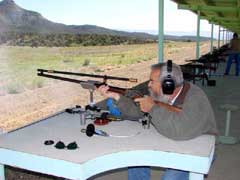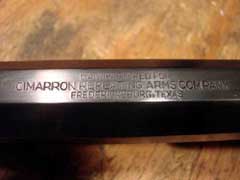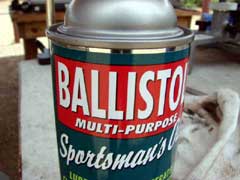|
It had been a full year since I had last seen
the Buffalo. He was standing in a clearing in the mountains
outside of Raton, New Mexico, and was like no other American
Bison that I had ever seen; solid white, with one black spot
on his left side. When I last saw him, he was standing broadside
at a distance of 1125 yards in that clearing. I had time to fire
only two shots at him. One connected, the other did not.
Now here I was, one year later, looking carefully and
deliberately with eyes squinted to try to find him again on the
side of that mountain, and there he stood, just as he had the
year before, in that same clearing, 1125 yards away.
We were meant to meet again, and I had spent a
lot of time in that long year thinking about that white buffalo.
The rifle that I had brought with me was one that I had acquired
for the sole purpose of shooting that old buffler. It was a Cimarron
.45-90 Sharps replica, fitted with a period-correct scope of the
type that was used by many buffalo hunters in the period of the
great American Bison slaughter of the 1800s. The scope was a Leatherwood
Malcolm six power long-tube model that has excellent optical
qualities for a scope of that type. It would allow me to clearly
see the buffler at long range, and the rear mount had plenty of
elevation adjustment to allow for a direct hold out to over a
half mile. The Cimarron Sharps wore a heavy octagon barrel that
measures a full thirty-two inches in length, and has double set
triggers to allow for a light, clean, crisp trigger release. I
had carefully assembled the cartridges using new Starline
cases loaded with some excellent Mt.
Baldy 530 grain bullets loaded over top of 82 grains of Goex
Express Ffg powder. The Goex Express powder offered the
consistency that I knew I would need to accurately connect on
the big buffler, and I needed all the help that I could get.
The Sharps replica that I used was the Cimarron
Armi Sport "Billy Dixon" model chambered for
the .45-90 cartridge. As mentioned above, it wears a thirty-two
inch full octagon barrel and a checkered walnut,
straight-gripped stock. The receiver, lever, lock, tangs, and
hammer are color case-hardened. The barrel, breech block,
and other small parts are blued finish. The rear sight is a
ladder type for shooting out to moderate ranges, and it wears a
blade front sight. The triggers are of the double-set style,
which results in a crisp, light pull for accurate long-range
work. The markings on the lock of the Cimarron Sharps are
imitative to the originals, and very tastefully done. The rifle
weighs in at just under ten and one-half pounds. The
Italian markings are small, and are on the bottom of the barrel.
The walnut forend has a pewter nose cap, and the butt-plate is
smooth case-hardened steel.
As mentioned earlier, I mounted a Leatherwood
Malcolm six power scope atop the Sharps using Leatherwood
mounts. The rear sight dovetail requires a .602 inch adapter,
which is available directly from Leatherwood. The scope and rear
elevation base can be ordered from Leatherwood or from Cimarron
along with the rifle. Using the Malcolm scope with its very
clear optics allowed me to easily see the buffalo for precise
sighting. The rear mount is adjustable for both windage
and elevation, and the front dovetail is adjustable for windage
correction. The rear adjustments on the standard mount are not
of the micrometer type, but are serviceable nonetheless.
Leatherwood has a Precision Mount in the works for the Malcolm
scope, but it was not ready in time for my trip to New Mexico.
The rifle with scope attached weighs twelve pounds and three
ounces. The deep blue-black finish with brass accents
looks great, and period correct, on the big Sharps.
On the day of the shoot, the wind was howling,
to put it mildly. Gusts were ranging as high as thirty miles per
hour at the shooting position. I donít know what it was doing
downrange. At that distance, it takes about three seconds for
the bullet to reach the target, and even a light breeze can make
hitting the target difficult. I had none other than the
legendary Mic McPherson spotting for me, and his advice
helped quite a bit. Whether by luck, skill, or accident, both Boge
and I were able to connect with the buffalo a few times, but we
missed more than we hit, which only adds to the fun, and the
frustration. Sometimes, a shot would hit high and off to the
left, and the next shot could go low and right, depending upon
that dern wind! However, I could not fault the rifle, scope, or
ammunition at all. I had sighted it in earlier with the same
combination, and out to 200 yards, accuracy was very impressive.
The Goex Express powder also exhibited very soft
fouling. I started out using a blow tube between shots, but
after a while, I decided to forego that and just shoot, as
fouling was not a problem. I sometimes fired as many as 40 shots
without cleaning the bore of the Sharps. The Goex Express
was introduced to compete with the Swiss powder that is so
popular with black powder cartridge competitors, and I believe
that it is at least the equal of the Swiss, if not better. It
costs more than the standard Goex powders, but is more expensive
to make. I like it. I used no special loading technique, except
to swirl the charge into the cases, seating a .060 inch fiber
wad with a dowel rod, slightly compressing the charge, and
seating the bullet atop with no crimp on the case mouths. The
Starline cases were very uniform in dimension, and the only
special care given to them was that I had my friend John
Knutson (www.handloads.com)
to anneal the case mouths for me. I used Federal Gold
Medal primers exclusively in the ammo. Cleaning the Sharps was
very easy, as the breech block is removed quickly without tools,
and running a couple of patches soaked with Ballistol
swiftly cleans the bore.
The big Cimarron Sharps proved to be just about
the ideal rifle with which to shoot (and shoot at) the steel
buffalo. I was very pleased with its looks, feel, and
performance. I also love that Leatherwood Malcolm scope. It not
only looks right on the Sharps, but I was genuinely impressed
with its optical qualities and performance. It was easy to use,
and not at all tiring on the eyes. I anxiously await the
Precision Mountís arrival. It will allow much more precise and
predictable sight adjustments.
While the trip to New Mexico to shoot the steel
buffler was an exercise in fun, the Cimarron/Leatherwood combo
would serve just as well in hunting for the real thing, and
maybe I will get the opportunity to shoot a bison later this
year. If I do, I can think of no other rifle that would be more
satisfying to use for such a task.
If you are in the market for a Sharps replica, I
highly recommend this Cimarron Billy Dixon model, and the
Leatherwood scope.
Check out the rifle online at: www.cimarron-firearms.com.
Look at the scope and mounts online at:
www.leatherwoodoptics.com.
You can order Starline brass direct at: www.starlinebrass.com.
Check out the Goex Express powder at: www.goexpowder.com.
You can order the excellent Mt. Baldy
precision-cast bullets, and the Ballistol cleaner from www.mtbaldybullets.com.
Jeff Quinn
  
Got something to say about this article? Want to agree (or
disagree) with it? Click the following link to go to the GUNBlast Feedback Page.
|
|
Click pictures for a larger version.

Jeff has a go at The Buffler. Note the elevation of the
scope required at 1125 yards.


1125 yards is a LONG way! The red rectangle in the top
picture indicates the location of the clearing where the White
Buffler waits in relative safety (bottom picture).


Having Mic McPherson as a spotter is like having Cy
Young as a pitching coach!



The Cimarron Sharps' iron sights consist of folding
ladder-style rear and "sourdough" front.



Leatherwood Malcolm six-power scope greatly aids both
long-range and historical accuracy.



Visible markings are in the authentic style, with the
required Italian proof markings hidden on the underside of the
barrel.








Loading the .45-90 with Goex Express Black Powder and
Mt. Baldy bullets into Starline cases.

C
|
![]()